In this article
Choosing a tent often feels like a frustrating trade-off between backpacking efficiency and front-country durability. The core of the blacktail tent vs tungsten tent debate is whether to sacrifice comfort for a lighter pack, or carry extra pounds for a shelter that can withstand the rigors of car camping. The Big Agnes Blacktail and Marmot Tungsten sit at this exact crossroads, making the decision a classic case of the “paradox of choice” for dedicated hikers. This isn’t just another spec sheet comparison. We’ve spent dozens of nights in these tents to give you a definitive verdict.
Here’s our promise to you:
- You will learn a clear, evidence-based framework for choosing the right camping tent.
- We will move beyond confusing spec sheets to focus on real-world performance.
- You will be matched with the ideal tent for your specific hiking style and priorities.
What Truly Matters in a Hiking Tent?
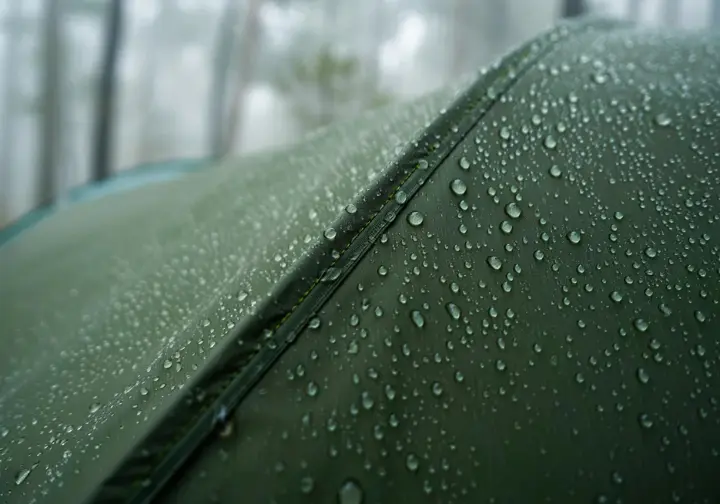
To make a smart, confident purchasing decision for any particular tent, it’s essential to first arm yourself with the foundational knowledge to decode tent specifications. Forget the marketing hype; these are the metrics that determine whether your shelter will be a sanctuary or a liability in the wild.
Why Does Tent Fabric Durability (Denier) Matter?
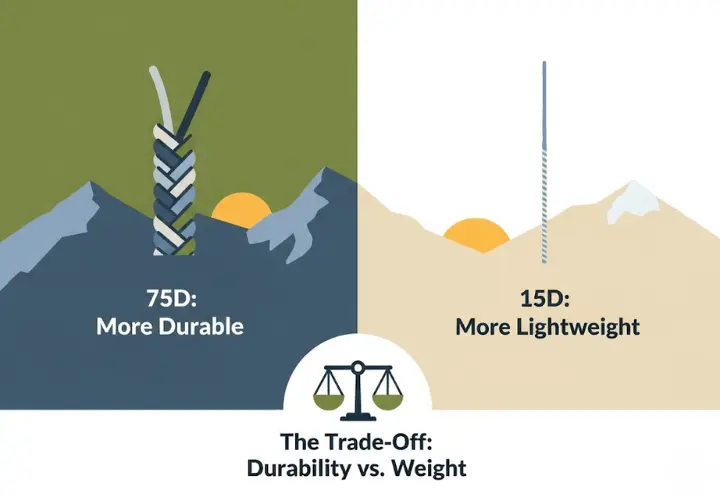
When you see a number followed by a “D” on a tent’s spec sheet, you’re looking at its denier—a direct measure of the fabric’s thread thickness and weight. A higher number, like the Big Agnes Blacktail’s robust 75D polyester fabric, signifies a heavier, more abrasion-resistant material built for heavy use. Conversely, ultralight tents might use a 15D cloth, prioritizing weight savings over brute strength. The Marmot Tungsten strikes a balance with its 68D materials, offering good durability without a significant weight penalty.
Critically, both the Blacktail and Tungsten use polyester for their main fabrics, which has a key advantage over nylon: it’s hydrophobic. This means it won’t sag or stretch when wet, ensuring your rainfly remains taut and sheds water effectively during a downpour. This durability-to-weight ratio is the core trade-off; the Blacktail’s higher denier offers peace of mind on rough terrain, while the Tungsten’s lighter tent body is more appealing for long-distance backpacking, as we detail in our complete guide to choosing the best hiking tent.
How is Tent Waterproofness Actually Measured?
A tent’s waterproofness is quantified by its Hydrostatic Head (HH) rating, measured in millimeters (mm). This standardized test determines how much water pressure a fabric can withstand before a single drop penetrates it. Think of it as a column of water being placed on the fabric; the higher the column before it leaks, the higher the HH rating. For three-season hiking in most North American and European climates, a rating of 1500mm is widely considered the “good enough” benchmark for being fully waterproof and capable of handling sustained, heavy weather. Both the Blacktail and Tungsten easily meet this critical standard.
However, staying dry goes beyond the numbers. Factory-taped seams, a smart design that prevents water from pooling, and a quality sil/pu tent fly are just as crucial. These elements work together to create a reliable shelter, a concept that holds true for all outdoor gear, similar to how we evaluate the best waterproof rain jackets. The methods for this testing are validated by industry standards for textile performance, ensuring the ratings you see are consistent and reliable.
How We Tested and What We Looked For
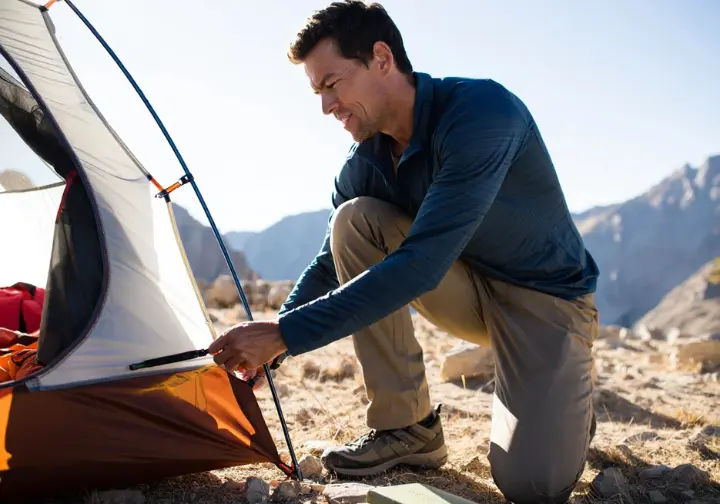
Our mission is to provide you with guidance you can trust implicitly. We are committed to objective, field-tested analysis, free from bias. Our recommendations are based solely on expert evaluation and real-world performance, with the singular goal of empowering you to choose the perfect shelter for your adventures. We are hikers, writing for fellow hikers.
Every tent was judged against the critical performance attributes that matter most in the backcountry: real-world durability, proven weather protection, overall livability, and total value. We scrutinized fabric denier, pole construction, interior space, ventilation, and the practicality of features like vestibules and interior pockets to ensure our recommendations are not just theoretical but grounded in practical, real-world application of this camping gear.
This isn’t a parking lot pitch test. Each tent series was evaluated over dozens of nights in the field, from the perpetually damp forests of the Pacific Northwest to the abrasive, rocky campsites of the Sierra Nevada. We pitched them in howling wind, endured multi-day rainstorms, and packed and unpacked them repeatedly. This rigorous process allowed us to assess their ease of setup, weather resilience, and long-term durability where it truly counts—far from the trailhead.
The final step was to translate this mountain of performance data and field notes into the clear, actionable recommendations that follow. Our goal is to move beyond a simple “winner” and instead match the right tent to the right person. We’ve distilled our experience into definitive verdicts for the different types of hikers we know and are.
The Best Hiking Tents of 2025: Our Top Picks
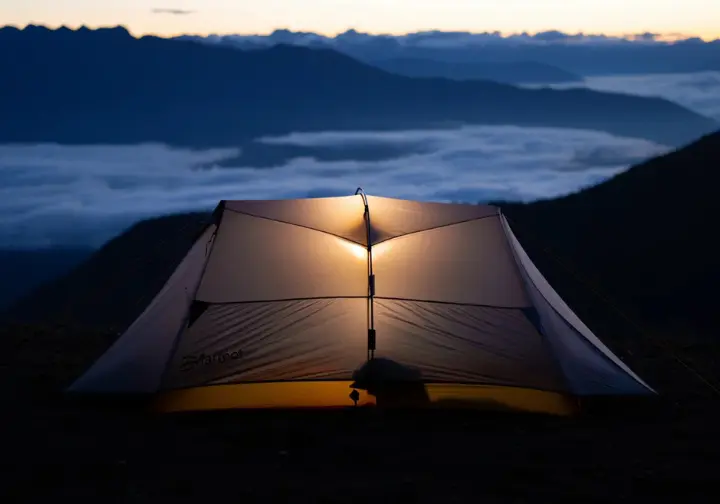
Here are our definitive verdicts from across the tent market, matching the best tent to your specific hiking profile and needs.
Best for the Weekend Warrior (Car Camping Focus)
When your car is just a short walk away, comfort, space, and bombproof durability take priority. For car campers, the extra pound or two is a worthy trade-off for a more livable and resilient base camp shelter.
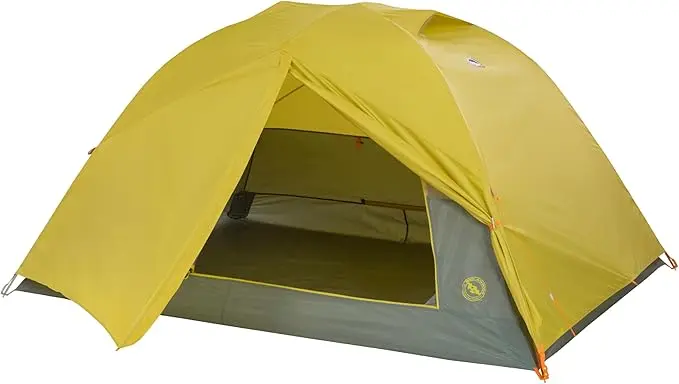
The Big Agnes Blacktail 3 is an exceptionally durable and spacious shelter that prioritizes comfort and ruggedness. It’s built with burly 75D recycled polyester on the fly and floor, a fabric that feels substantial and ready to handle repeated setups on a less-than-perfect tent pad. Its key strength is livability; the pre-bent aluminum poles create near-vertical walls, maximizing the 44-inch peak height and generous 44 sq. ft. floor area. This isn’t just a place to sleep; it’s a comfortable space to wait out a storm. While its packed weight of over 6 lbs makes it a poor choice for serious backpacking, it’s a fortress for front-country adventures and weekend trips where weight is not the primary concern.
PROS
- Exceptionally spacious and roomy interior
- Very easy and quick to set up, even for one person
- Durable fabrics stand up to heavy use
CONS
- Zippers can be sticky and are a long-term concern
- Too heavy for serious backpacking trips
- Footprint for protection is sold separately
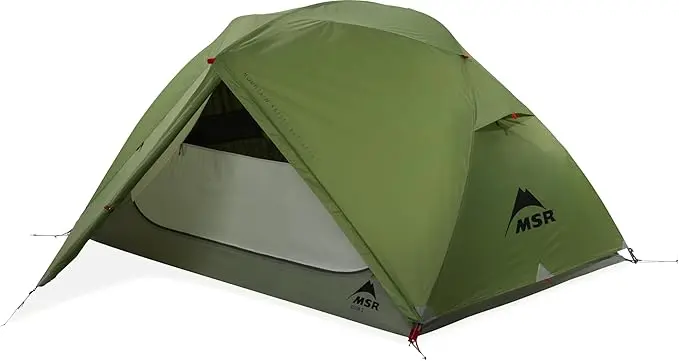
The MSR Elixir 2 represents a fantastic balance of livability, user-friendly design, and outstanding value. MSR’s unique pole geometry, combining two main poles with a shorter cross-pole, optimizes headroom and creates a surprisingly spacious interior for a 2-person tent. The setup is brilliantly intuitive, with color-coded poles, clips, and webbing that make for a lightning-fast pitch. Its combination of 68D ripstop polyester on the fly and a tougher 75D floor fabric provides solid 3-season weather protection. Crucially, the MSR Elixir 2 often includes a footprint, delivering excellent out-of-the-box value. While it’s not the lightest option, this well-balanced tent with its blend of robust construction and thoughtful features makes it a top-tier choice for versatile campers.
PROS
- Very spacious interior for a 2-person tent
- Extremely easy and intuitive setup process
- Excellent value, often includes a footprint
CONS
- Heavy and bulky for ultralight backpacking
- Inner-first pitch can get wet in a downpour
- Included tent pegs are somewhat flimsy
Best for the Aspiring Thru-Hiker (Backpacking Focus)
For those who measure trips in miles and days, not just weekends, every ounce matters. These backpackers need a reliable, trail-worthy backpacking tent that finds the sweet spot between low weight, proven durability, and great value.
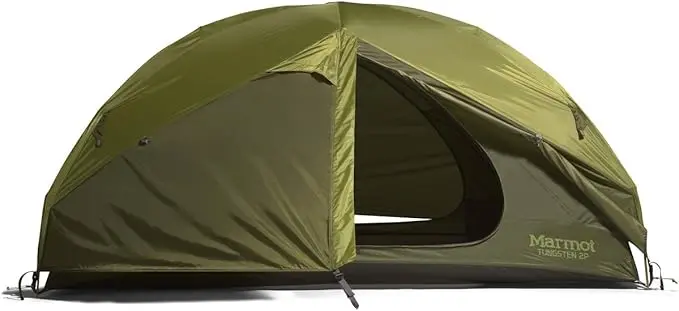
The Marmot Tungsten 2P is a true do-it-all backpacking tent that strikes a near-perfect balance between a reasonable packed weight, proven durability, and outstanding value. Its 68D polyester ripstop rainfly and floor fabric are substantially durable for backcountry use without the weight penalty of a pure car-camping tent. The “Zone pre-bend” construction creates more vertical walls, making its 30.1 sq. ft. of floor space feel incredibly roomy. Its critical advantage in multi-day storms is the polyester rainfly, which resists sagging when wet, ensuring it remains taut and keeps you dry. The greatest value proposition for those on a budget, however, is that the Tungsten 2P includes a footprint, meaning you get a complete, protected shelter system without any extra cost.
PROS
- Excellent balance of space, weight, and durability
- Superb value, as footprint is included
- Polyester fly doesn’t sag or stretch when wet
CONS
- Can be tricky to get the rainfly perfectly taut
- Packed length can be awkward in some packs
- Considered heavy by ultralight standards
Best for the Multi-Sport Explorer (Bikepacking/Kayak Camping)
When your adventures involve bikes, boats, or other bulky gear, simple storage isn’t enough—you need a mobile base camp. These explorers need massive, protected shelters to organize gear without compromising the inner tent’s living area, making a tent like the Blacktail Hotel a prime candidate.
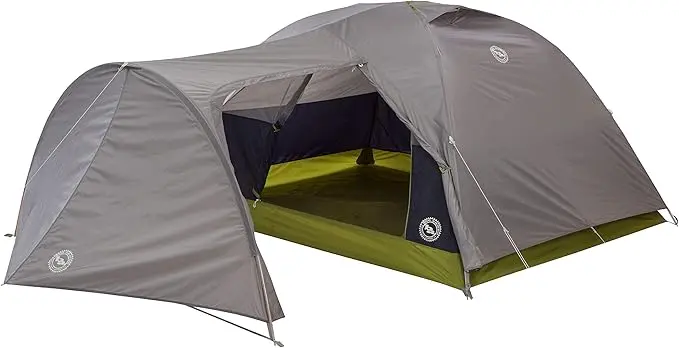
For bikepacking and kayak camping, the Big Agnes Blacktail 2 Hotel is a game-changer. It takes the durable and livable design of the standard Blacktail 2 and adds a massive, pole-supported extended vestibule. This “Hotel” feature creates a cavernous 28 sq. ft. protected garage that acts as a large canopy, perfect for storing bike panniers, paddles, and wet gear, or even sheltering a large dog. This keeps your main tent—built with the same robust 75D polyester fabric—clean and organized. The bikepack version includes a Shortstik Poleset that packs down to 12 inches, making it easy to strap to handlebars. While the enormous vestibule adds significant weight and bulk, making it unsuitable for traditional backpacking, it provides an unmatched level of sheltered living space for gear-intensive pursuits.
PROS
- Massive extended vestibule offers huge gear storage
- Bikepack version has a very compact packed size
- Durable fabrics are ideal for rough use
CONS
- Heavy and bulky, not for traditional backpacking
- Known issues with long-term zipper durability
- Large footprint requires a big campsite
Final Considerations & Common Mistakes to Avoid
Choosing wisely means avoiding common purchasing errors. Our final expert advice will help you prevent frustration on the trail and lead to many nights of happy camping.
The “Size Up” Rule: User consensus is clear: a 2-person tent is often a “palace for one” or a cozy, shoulder-to-shoulder fit for two. If you want comfortable living space for two people and their gear, especially on a rainy day, we strongly recommend a 3-person model.
The Footprint Factor: Don’t just compare sticker prices. The Marmot Tungsten almost always includes a custom-fit footprint, which is a $40-$50 value. This accessory protects your tent floor from abrasion and punctures, extending its life significantly. Factoring this in makes the Tungsten’s total upfront cost much lower than the Big Agnes Blacktail, for which the footprint must be purchased separately.
The Zipper Question: Be aware of the multiple user reports concerning premature zipper failure on the Big Agnes Blacktail series. While the 75D fabric is exceptionally tough, a tent is only as strong as its weakest link. This potential point of failure is a critical consideration for anyone planning remote trips where a broken zipper could be a serious problem.
Check the Return Policy: Always buy your tent from a retailer with a solid return and exchange policy. The only way to truly know if a tent is right for you is to set it up in your living room. Lay out your sleeping pads and bags, sit up inside, and check the headroom. This simple test can save you from a very expensive and uncomfortable mistake.
Frequently Asked Questions about the Blacktail and Tungsten Tents
Which tent is better for rain, the Blacktail or the Tungsten?
Both tents offer excellent waterproof performance with 1500mm HH ratings and factory-taped seams. However, the Marmot Tungsten has a slight edge in prolonged, damp conditions because its polyester rainfly does not sag or stretch when it gets wet, maintaining its taut pitch. For hikers who frequently camp in rainy climates, the Marmot Tungsten is the recommended choice.
Do I really need a 3-person tent for two people?
While a 2-person tent will technically fit two standard-width sleeping pads, it leaves very little room for gear or movement. For comfortable living space, especially if you get stuck in the tent during bad weather, most experienced hikers recommend sizing up. If you regularly camp with a partner, a dog, or simply value more interior space to organize gear, a 3-person model like the Marmot Tungsten 3P is a highly recommended option.
Is the Big Agnes Blacktail worth the price if the footprint is sold separately?
The Blacktail’s value depends entirely on your priority. If maximum fabric durability for frequent car camping or use on abrasive surfaces is your primary goal, the robust 75D material may justify the extra cost of the tent and the separate footprint. However, for most users, the Marmot Tungsten offers superior out-of-the-box value. For the most value-conscious buyer, the Marmot Tungsten 2P is the better financial decision as it includes the footprint.
Which tent is more durable?
This is a two-part answer. The Big Agnes Blacktail uses a heavier, more abrasion-resistant fabric (75D vs. the Tungsten’s 68D/70D). However, based on widespread user feedback, the Marmot Tungsten appears to have more reliable components, specifically lacking the recurring complaints about premature zipper failure that plague the Blacktail. For overall long-term reliability and peace of mind on remote trips, the Marmot Tungsten has a more proven track record.
Risk Disclaimer: Hiking, trekking, backpacking, and all related outdoor activities involve inherent risks which may result in serious injury, illness, or death. The information provided on The Hiking Tribe is for educational and informational purposes only. While we strive for accuracy, information on trails, gear, techniques, and safety is not a substitute for your own best judgment and thorough preparation. Trail conditions, weather, and other environmental factors change rapidly and may differ from what is described on this site. Always check with official sources like park services for the most current alerts and conditions. Never undertake a hike beyond your abilities and always be prepared for the unexpected. By using this website, you agree that you are solely responsible for your own safety. Any reliance you place on our content is strictly at your own risk, and you assume all liability for your actions and decisions in the outdoors. The Hiking Tribe and its authors will not be held liable for any injury, damage, or loss sustained in connection with the use of the information herein.
Affiliate Disclosure: We are a participant in the Amazon Services LLC Associates Program, an affiliate advertising program designed to provide a means for us to earn advertising fees by advertising and linking to Amazon.com. As an Amazon Associate, we earn from qualifying purchases. We also participate in other affiliate programs and may receive a commission on products purchased through our links, at no extra cost to you. Additional terms are found in the terms of service.




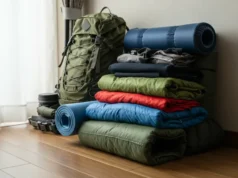
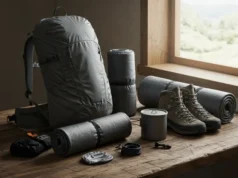



![Trek Budgeting: A Data-Backed Guide [+ Free Template] A trekker sits at a desk planning a trip budget on a laptop, with a stunning view of the Himalayan mountains visible through a window behind them.](https://thehikingtribe.com/wp-content/uploads/2025/07/00-trek-budgeting-data-backed-planning-100x75.webp)

